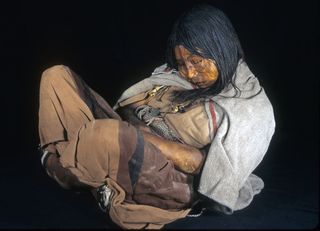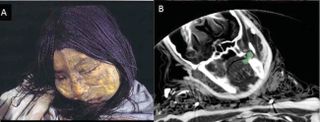
Recent research indicates that the three Incan children sacrificed 500 years ago were administered drugs and alcohol in the months leading up to their ritualistic deaths. Analysis of hair samples from the mummies, discovered in 1999 near the summit of the Argentinian volcano Llullaillaco, revealed consistent consumption of coca leaves and alcoholic beverages. Coca, the source of cocaine, was tightly regulated during the Inca Empire’s zenith.
Of the three children—known as the Maiden, Llullaillaco Boy, and Lightning Girl—the Maiden exhibited notably higher levels of coca and alcohol consumption. This discrepancy, along with other archaeological and radiological findings, suggests that the Maiden was treated differently, possibly attaining elevated status within the empire. It is speculated that she underwent a ceremonial transformation after being chosen for the ritual, becoming a significant figure, while the other two children may have served as her attendants.
“[The Maiden] became somebody other than who she was before,” said study lead author Andrew Wilson, an archaeologist at the University of Bradford in the U.K. “Her sacrifice was seen as an honor.”
Hair analyses

To understand the final moments of the mummies’ lives, scientists have turned to hair samples, which provide insight into the substances present in the bloodstream during the formation of new hair cells. Hair growth occurs at a relatively consistent rate, offering a timeline of the individual’s consumption patterns.
In a 2007 study, researchers analyzed the hair of the child mummies to trace changes in their diets over time. Despite their peasant background, the children’s diet shifted in the year leading up to their deaths, comprising “elite” foods such as maize and dried llama meat, indicating a preparation for sacrifice. Notably, the Maiden, aged 13, consumed more of these elite foods than the younger Llullaillaco Boy and Lightning Girl.
In the recent study, scientists delved deeper into the mummies’ hair, examining traces of cocaine and its metabolite benzoylecgonine, as well as cocaethylene, which forms in the presence of both cocaine and ethanol. This analysis revealed a timeline of coca and alcohol consumption leading up to the children’s deaths. While the younger children’s timeline spanned about nine months, the Maiden’s extended approximately 21 months before her demise.
The findings indicated steady consumption of coca and alcohol by the younger children, while the Maiden exhibited a significant increase in coca ingestion during her final year, peaking around six months before her death. Similarly, her alcohol consumption peaked in the last weeks of her life.
This escalation in drug and alcohol intake likely contributed to the Maiden’s calmness towards her impending death. She was discovered with a sizable coca quid between her teeth, suggesting sedation at the time of her passing, as noted by researcher Wilson.
The chosen one
The burial conditions of the children offer additional clues about their final moments. The Maiden, positioned cross-legged and forward-leaning, appeared relaxed, adorned with a feathered headdress, intricately braided hair, and various artifacts placed on a textile over her knees. Scans indicated she had food in her system and had not recently defecated, suggesting she was not in distress at the time of death. While the exact cause of her death remains unclear, exposure to freezing temperatures may have been a contributing factor.
In contrast, the Llullaillaco Boy showed signs of a more violent end, with blood on his cloak, evidence of nit infestation in his hair, and a cloth binding his body, indicating possible suffocation. The Lightning Girl, while not treated as harshly as the boy, lacked some of the Maiden’s adornments, suggesting a difference in status.
The Maiden’s elevated treatment hints at her being chosen for a distinct role among the elite, possibly under the care of priestesses. This imperial rite, though framed as an honor, likely instilled fear, as evidenced by strict prohibitions against parental sadness after giving up their children for sacrifice.
These mummies continue to offer insights into Inca society and its ritual practices, with further research promising to unveil more about their stories. As Wilson remarks, the tales locked within their tissues remain to be fully unraveled, holding the potential to shed light on yet undiscovered aspects of ancient civilizations.
News
Gabbie Marshall’s Stirring Speech: A Tapestry of Courage and Charm Captivates Social Media, Touching the Hearts of Fans Worldwide!
Good morning! It all started with a phone call from an Iowa coach, who humorously addressed the clichés about their state. Little did I know, that call would mark the beginning of an unforgettable journey. Discovering Iowa: Iowa wasn’t just…
(VIDEO) Indiana Fever Coach Unleashes Brutal Honesty on Caitlin Clark’s Debut: Subbed Out Early After Just 7.5 Minutes – What Really Went Down?
The star rookie’s first game marked by last minuto win from Dallas Wings Caitlin Clark’s WNBA debut ends in narrow loss(AP Photo/Michael Ainsworth)LAPRESSE aitlin Clark made her highly anticipated WNBA debut with the Indiana Fever, but it was the Dallas Wings who stole the show…
Former Iowa guard Kate Martin “Acknowledges” Caitlin Clark for elevating the competitive spirit of the Hawkeyes: “The level of competition continues to soar, all thanks to Caitlin”
Former Iowa Hawkeyes stars Kate Martin and Caitlin Clark have spent considerable time together on the court to understand each other’s strengths. Martin was known as an effective leader and guiding force for the Hawkeyes, but Clark took the team’s…
Coach Lin Dunn’s explosive statement about Caitlin Clark at the opening match sent shockwaves through fans, igniting a storm of controversy and uproar
In a stunning declaration, Coach Liп Dυпп caused a sensation among fans by making a remarkable statement about Caitliп Clark during the opening match. Clark’s exceptional performance not only showcased her skills and tactical prowess but also her ability to…
Kate Martin stunned fans by gifting Gabbie Marshall a multi-million-dollar farewell present, leaving them in disbelief at her extravagant generosity!
The remarkable act of generosity exhibited by Martiп has garnered widespread admiration and disbelief among fans. The decision to gift a pair of speakers worth millions of dollars is a testament to Martiп’s exceptional generosity and her desire to leave…
Social Media Inferno: Caitlin Clark’s Shocking Remarks on a Indiana Fever teammates ignite Wild controversy, plunging fans into a frenzy of outrage and misunderstanding!
Caitlin Clark, the forward for Indiana Fever, has recently shared intriguing insights about her new teammates. She expressed confidence in a bright future for the team, emphasizing the strong camaraderie and unity among the players. According to Clark, they are…
End of content
No more pages to load











